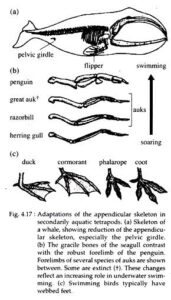Back to: ZOOLOGY 400 Level
Welcome to class!
Hello my brilliant learner! It’s always exciting to have you in class. Imagine a fish gliding through water or a lizard sunbathing on a rock — have you ever wondered how these animals survive so well in their different homes? That’s exactly what we’re learning about today: Adaptations in Aquatic and Terrestrial Animals. It’s going to be fun, simple, and deeply connected to the world around you.
Adaptations In Aquatic And Terrestrial Animals
Animals live in all sorts of environments — from deep oceans to dry deserts. To survive, they develop adaptations — special features or behaviours that help them thrive in their habitat.

Aquatic Animals
These are animals that live in water — like fish, whales, frogs, and crabs. Their adaptations help them move, breathe, feed, and reproduce underwater.
Body Shape: Most aquatic animals have streamlined (smooth, narrow) bodies that reduce resistance while swimming. Think of a catfish or dolphin — their shape helps them glide easily through water.
Respiration: Many fish use gills to extract oxygen from water. Frogs, which live both on land and in water, can breathe through their skin when underwater.
Limbs and Movement: Fins, flippers, and webbed feet are common in aquatic animals. These help them swim efficiently. Crocodiles and frogs have webbed toes to help in swimming.
Reproduction: Many lay eggs in water, which hatch into free-swimming larvae — like tadpoles in frogs.
Buoyancy Control: Some fish have a swim bladder, a gas-filled organ that helps them float or sink.
Terrestrial Animals
These are animals that live on land — like goats, dogs, elephants, or even ants. They’ve got unique features that help them handle challenges like walking on rough land, avoiding drying out, and breathing air.
Locomotion: Strong limbs and supportive skeletons help them walk, run, or jump. Think of the springy legs of an antelope or the firm claws of a lizard.
Skin and Coverings: Terrestrial animals usually have dry skin, fur, scales, or feathers to protect them from losing water. For example, snakes have scales to prevent water loss.
Respiration: Land animals use lungs to breathe air. Birds, mammals, and reptiles all rely on lungs.
Water Conservation: Many have kidneys that concentrate urine to reduce water loss — like the desert rat, which hardly ever drinks water.

Reproduction: Many lay eggs with protective shells or give birth to live young, allowing survival outside water.
Example: Picture a tilapia and a goat. The tilapia uses gills to breathe and fins to swim, while the goat uses lungs to breathe and strong legs to climb hills and graze.
Summary
- Animals adapt to their environment to survive and reproduce.
- Aquatic animals have streamlined bodies, gills, and fins or flippers.
- Many aquatic animals reproduce by laying eggs in water.
- Terrestrial animals have lungs, strong limbs, and water-saving features like dry skin and efficient kidneys.
- Each group has physical and behavioural features that match its environment.
Evaluation
- What is an adaptation?
- Name two adaptations that help fish live in water.
- How do terrestrial animals prevent water loss?
- Give one example of an aquatic and a terrestrial animal and one adaptation each.
- What organ do most land animals use for breathing?
Amazing work today! You’ve just learnt how animals shape their bodies and lives to suit their homes — whether swimming deep in rivers or roaming dry savannahs. Keep that energy going because with Afrilearn, every class brings you closer to greatness. You’re doing so well — keep shining and learning like the star you are!
